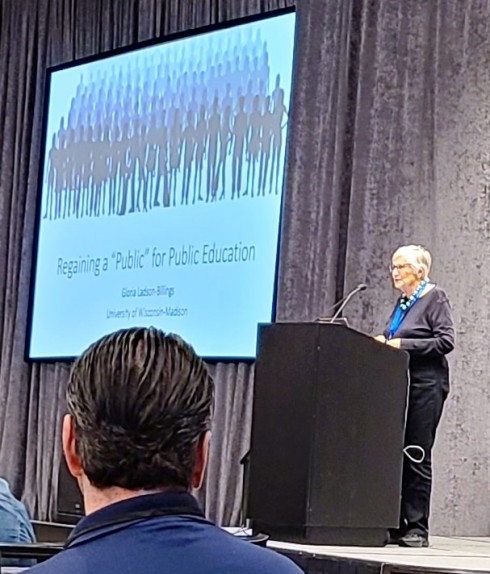By Thomas Ultican 4/19/2024
I am sure you’ll be shocked to your core but there are some really bad people out there trying to end publicly-financed free education.
Since the beginning to the 21st millennium, misguided wealthy people have been attacking public education. The reasons range from religion to hubris. Betsy DeVos thinks secular education is an insult to her Christian God. Bill Gates believes he knows more than anyone else and Charles Koch is opposed to all government-sponsored social action. That would all be fine if they were not billionaires, using immense wealth to impose their way.
Truth-in-Funding (TiF) offers tools for opposing their propaganda with a webpage providing links to 25 organizations, working to protect public schools. Organizations such as National Education Policy Center, Network for Public Education and Education Law Center share links to their research along with toolkits for delivering the message.
The Truth-in-Funding Group
TiF’s homepage states:
“School voucher programs use public funds to pay for private education costs. These programs are spreading despite overwhelming evidence that they are harmful public policy.”
And their about page says:
“This website offers a wide range of tools from groups that oppose vouchers and other efforts to divert public funding in education. We work to protect the vital institution of public education and ensure all students have access to welcoming, well-resourced public schools.”
Highlighted Materials
Network for Public Education (NPE) was founded in 2013 by a middle-school teacher from Oakland, California, Anthony Cody and former Education Department official and education historian, Diane Ravitch. Soon after the founding, past New York principal of the year, Carol Burris, came on board as director. NPE has focused on uniting friends of public schools, researching the reality behind school choice and creating tools to protect public education.
Ravitch Introducing Keynote Speaker Gloria Ladson-Billings
At NPE Washington DC October 2023
One of NPE’s many “Toolkits”, which are concise two-page documents, is “Do charter schools and school vouchers “hurt” public schools?” The answer is:
“Yes.
“Charter schools, vouchers, and other “choice” options redirect public money to privately operated education enterprises, some of which operate for profit. That harms your public schools by siphoning off students, resources, and funding and reducing the ability of public schools to serve the full range of student needs and interests.”
This conclusion was justified with four paragraphs of explanation and eight examples from across America.
Policy Matters Ohio is a non-profit policy research institute. Funded by mostly small foundations and individual donations they claim to “create a more vibrant, equitable, sustainable and inclusive Ohio through research, strategic communications, coalition building and policy advocacy.”
Their 2023 Ohio voucher study concluded:
- “Ohio is currently ranked 46th for per-pupil equitable distribution of funding. State funding that is allocated towards vouchers should be directed to public schools so that students can get the resources they need to thrive.
- “Ohio public schools need funding, especially our largest urban school districts with high concentrations of Black, Brown, and Economically disadvantaged students (CCS example)
- “Ohio is ranked 40th in starting teacher salaries, and falls below the national average. Funding allocated towards vouchers takes away from money that should be invested in our educators. Can help us to recruit and retain more teachers in the state
- “Private schools can choose to kick back a child, but as of right now they would be able to keep the money that was awarded, this needs to be changed so that private schools are not benefiting from public dollars for a child they are not educating .
- “With universal vouchers comes universal bussing costs for public-school districts who bear the cost of transporting all district voucher students to private schools. Property taxes will continue to rise as the public is forced to pay a billion dollars for private school tuition, which will strain lower income districts.”
With the advent of billionaire-financed attacks on public education, non-peer reviewed policy reports and education outcome studies have become prevalent. In response, a group of scholars created the National Education Policy Center (NEPC), housed at the University of Colorado to test the claims being made.
In 2023, there was a legislatively mandated report by the Georgia Department of Audits and Accounts estimating costs and benefits of the state’s new Qualified Education Expense tax credit (QEEC). It is a tax credit school voucher scheme that provides families with “scholarships”. These programs can be controversial because they send taxpayer funding to private schools which serve primarily religious schools that regularly exclude students based on faith, sexual orientation or disability. The Georgia report concluded the state would save money with these vouchers.
David S. Knight, University of Washington, studied the report for NEPC and concluded:
“Taken together, little evidence or data supports the report’s main findings and conclusions. If more accurate parameters are used to generate cost estimates, particularly for the switcher rate and for the cost savings of declining enrollment, a different picture emerges. While the report concludes that the tax-credit scholarship program will have a positive fiscal impact, a far more likely scenario, and one that has already played out in other states, is that the tax credit will cost Georgia taxpayers millions of dollars, potentially requiring future cuts to public services, while providing a cash bonus to many wealthy families.”
A visitor to the TiF library page discovers 13 hyper-linked categories including “Graphics” where I found this:
A Big Concern
At the bottom of TiF’s main page, below the 25 hyper-linked partners, is a link to Partnership for the Future of Learning (PFL) with an invitation to visit their website.
Learning Policy Institute is listed as a member of the PFL network, founded in 2015 with Stanford professor Linda Darling-Hammond in charge and offices in Palo Alto and Washington DC. San Francisco-based Sandler Foundation was the lead funder with Atlantic Philanthropies, S.D. Bechtel, Jr. Foundation, Ford Foundation, William and Flora Hewlett Foundation. Stuart Foundation also provided initial support.
The Ford, Bechtel and Hewlett foundations have often supported initiatives that undermine public schools. The Hewlett foundation joined Zuckerberg and Kellogg in funding PFL. Hewlett’s 2022 form 990-PF (EIN: 94-1655673) reports grants of $600,000 to NWEA, $533,336 to Education Trust and $1,935,000 to the Aspen Institute.
Learning Policy Institute’s 2022 tax report lists Darling-Hammond’s salary at over $500,000 (EIN: 47-2772048). She has a history of being both supportive of public education and a problem. My friend, Steven Singer, titled his 2018 post about Darling-Hammond, “Linda Darling-Hammond vs. Linda-Darling Hammond – How a Once Great Educator Got Lost Among the Corporate Stooges.” While often brilliant, she does not seem to value the importance of school governance.
Another PFL partner, WK Kellogg Foundation, is one of America’s largest grant-making organizations. A quick perusal of their 990-PF tax forms (EIN: 38-1359264) showed many grants to clearly worthwhile causes. Unfortunately they also give money to organizations like Teach For America, who pawns off fake temp-teachers on America’s students. Their 2021 form gives the most recent spending data available from Kellogg, with the following partial table of giving:
PFL cites Teach Plus as a network partner. It is a private company trying to monetize teacher-training, established in 2007 by Celine Coggins, a professor at Harvard Innovation Labs. Her Harvard resume says, “Under Celine’s leadership, Teach Plus grew to over 30,000 participating teachers and a $10M annual operating budget by offering groundbreaking programs in leadership development and advocacy.” The actual groundbreaking was the effort to replace teacher-leadership and -training by established public universities like UCLA, University of Texas and University of Illinois, with a for-profit company.
PFL may be a true friend of public education but some of the organizations they listed are not. Until they clean their house of organizations that harm public education, TiF should reconsider giving them a link on their otherwise pristine webpage.
I do not want to overemphasize TiF’s one questionable link but am sensitive about the issue. Every national education news source now receives funding from Bill Gates. In addition, other billionaire enemies of public schools also contribute to school news outlets like The 74, education week etc. There are few places for the public to get true un-slanted education news.
So far Truth-in-Funding appears to be a valuable resource for fighting misinformation and saving universal free public education.










